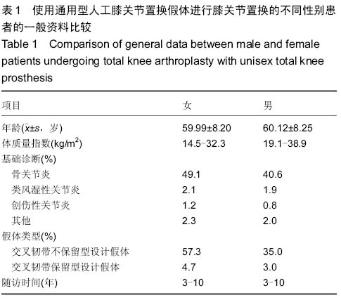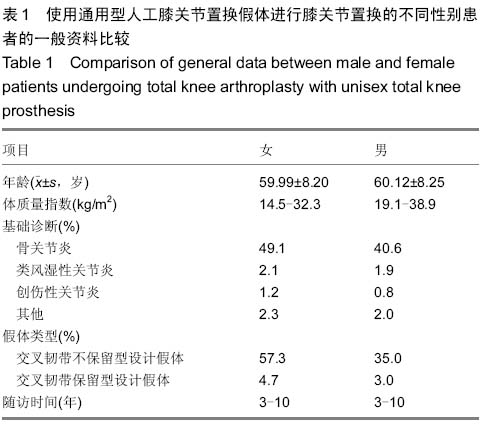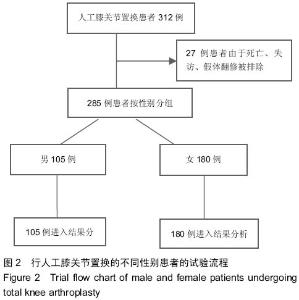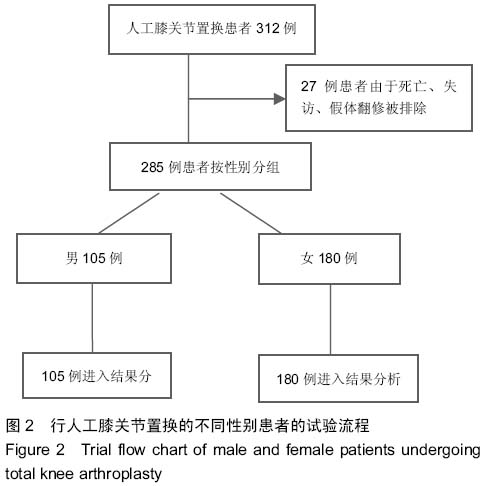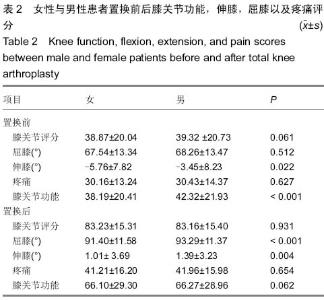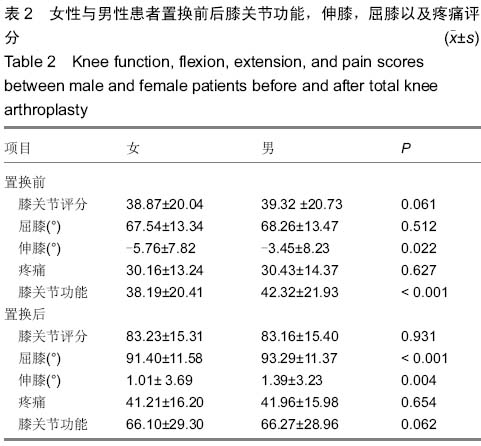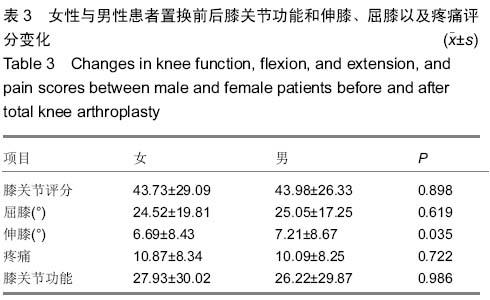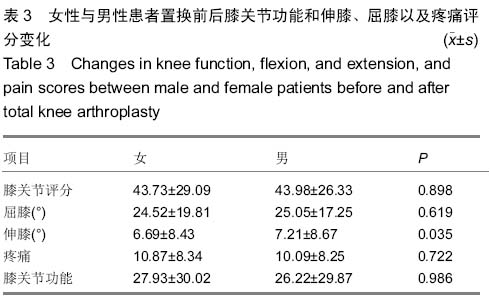| [1] Jones CD. Gender differences in patellofemoral joint biomechanics. Clin Orthop Relat Res. 2004;(419):317; author 317-318.
[2] Chaichankul C, Tanavalee A, Itiravivong P. Anthropometric measurements of knee joints in Thai population: correlation to the sizing of current knee prostheses. Knee. 2011;18(1): 5-10.
[3] Whiteside LA, Arima J. The anteroposterior axis for femoral rotational alignment in valgus total knee arthroplasty. Clin Orthop Relat Res. 1995;(321):168-172.
[4] Matsuda S, Miura H, Nagamine R, et al. Effect of femoral and tibial component position on patellar tracking following total knee arthroplasty: 10-year follow-up of Miller-Galante I knees. Am J Knee Surg. 2001;14(3):152-156.
[5] Omololu BB, Ogunlade OS, Gopaldasani VK. Normal Q-angle in an adult Nigerian population. Clin Orthop Relat Res. 2009; 467(8):2073-2076.
[6] Livingston LA, Mandigo JL. Bilateral Q angle asymmetry and anterior knee pain syndrome. Clin Biomech (Bristol, Avon). 1999;14(1):7-13.
[7] El-Ashker S, Carson BP, Ayala F, et al. Sex-related differences in joint-angle-specific functional hamstring-to-quadriceps strength ratios. Knee Surg Sports Traumatol Arthrosc. 2015. in press.
[8] Ishimaru M, Hino K, Onishi Y, et al. A three-dimensional computed tomography study of distal femoral morphology in Japanese patients: gender differences and component fit. Knee. 2014;21(6):1221-1224.
[9] Pinskerova V, Nemec K, Landor I. Gender differences in the morphology of the trochlea and the distal femur. Knee Surg Sports Traumatol Arthrosc. 2014;22(10):2342-2349.
[10] Yan M, Wang J, Wang Y, et al. Gender-based differences in the dimensions of the femoral trochlea and condyles in the Chinese population: correlation to the risk of femoral component overhang. Knee. 2014;21(1):252-256.
[11] Lim HC, Bae JH, Yoon JY, et al. Gender differences of the morphology of the distal femur and proximal tibia in a Korean population. Knee. 2013;20(1):26-30.
[12] von Roth P, Matziolis G, Pfitzner T, et al. Early results of gender-specific posterior stabilized total knee arthroplasty without patella resurfacing. Orthopade. 2013;42(10):866-873.
[13] Piriou P, Mabit C2, Bonnevialle P3, et al. Are gender-specific femoral implants for total knee arthroplasty necessary? J Arthroplasty. 2014;29(4):742-748.
[14] Dalury DF, Mason JB, Murphy JA, et al. Analysis of the outcome in male and female patients using a unisex total knee replacement system. J Bone Joint Surg Br. 2009;91(3): 357-360.
[15] Song EK, Jung WB, Yoon TR, et al. Comparison of outcomes after bilateral simultaneous total knee arthroplasty using gender-specific and unisex knees. J Arthroplasty. 2012; 27(2):226-231.
[16] Cheng T, Zhu C, Wang J, et al. No clinical benefit of gender-specific total knee arthroplasty. Acta Orthop. 2014; 85(4):415-421.
[17] Kastner N, Gruber G, Aigner BA, et al. Sex-related outcome differences after implantation of low-contact-stress mobile-bearing total knee arthroplasty. Int Orthop. 2012; 36(7):1393-1397.
[18] Johnson AJ, Costa CR, Mont MA. Do we need gender-specific total joint arthroplasty? Clin Orthop Relat Res. 2011;469(7):1852-1858.
[19] Liow RY, Walker K, Wajid MA, et al. Functional rating for knee arthroplasty: comparison of three scoring systems. Orthopedics. 2003;26(2):143-149.
[20] Gandhi R, Tsvetkov D, Davey JR, et al. Survival and clinical function of cemented and uncemented prostheses in total knee replacement: a meta-analysis. J Bone Joint Surg Br. 2009;91(7):889-895.
[21] Emmerson KP, Moran CG, Pinder IM. Survivorship analysis of the Kinematic Stabilizer total knee replacement: a 10- to 14-year follow-up. J Bone Joint Surg Br. 1996;78(3):441-445.
[22] Hooper G, Rothwell A, Frampton C. The low contact stress mobile-bearing total knee replacement: a prospective study with a minimum follow-up of ten years. J Bone Joint Surg Br. 2009;91(1):58-63.
[23] Livingston LA, Mandigo JL. Bilateral Q angle asymmetry and anterior knee pain syndrome. Clin Biomech (Bristol, Avon). 1999;14(1):7-13.
[24] Tella BA, Ulogo U, Odebiyi DO, et al. Gender variation of bilateral Q-angle in young adult Nigerians. Nig Q J Hosp Med. 2010;20(3):114-116.
[25] Yang B, Yu JK, Zheng ZZ, et al. Comparative study of sex differences in distal femur morphology in osteoarthritic knees in a Chinese population. PLoS One. 2014;9(2):e89394.
[26] Yan M, Wang J, Wang Y, et al. Gender-based differences in the dimensions of the femoral trochlea and condyles in the Chinese population: correlation to the risk of femoral component overhang. Knee. 2014;21(1):252-256.
[27] Hitt K, Shurman JR 2nd, Greene K, et al. Anthropometric measurements of the human knee: correlation to the sizing of current knee arthroplasty systems. J Bone Joint Surg Am. 2003;85-A Suppl 4:115-122.
[28] 朱志刚,金大地,罗吉伟,等.股骨远端解剖形态性别差异与假体形态设计的关系[J].中国临床解剖学杂志,2008,26(4): 386-388.
[29] Woodland LH, Francis RS. Parameters and comparisons of the quadriceps angle of college-aged men and women in the supine and standing positions. Am J Sports Med. 1992;20(2): 208-211.
[30] Grelsamer RP, Dubey A, Weinstein CH. Men and women have similar Q angles: a clinical and trigonometric evaluation. J Bone Joint Surg Br. 2005;87(11):1498-1501.
[31] Vincent HK, Alfano AP, Lee L, et al. Sex and age effects on outcomes of total hip arthroplasty after inpatient rehabilitation. Arch Phys Med Rehabil. 2006;87(4):461-467.
[32] Attar FG, Khaw FM, Kirk LM, et al. Survivorship analysis at 15 years of cemented press-fit condylar total knee arthroplasty. J Arthroplasty. 2008;23(3):344-349.
[33] Scuderi GR, Sikorskii A, Bourne RB, et al. The Knee Society Short Form Reduces Respondent Burden in the Assessment of Patient-reported Outcomes. Clin Orthop Relat Res. 2015. in press.
[34] Paxton EW, Fithian DC. Outcome instruments for patellofemoral arthroplasty. Clin Orthop Relat Res. 2005; (436):66-70. |
